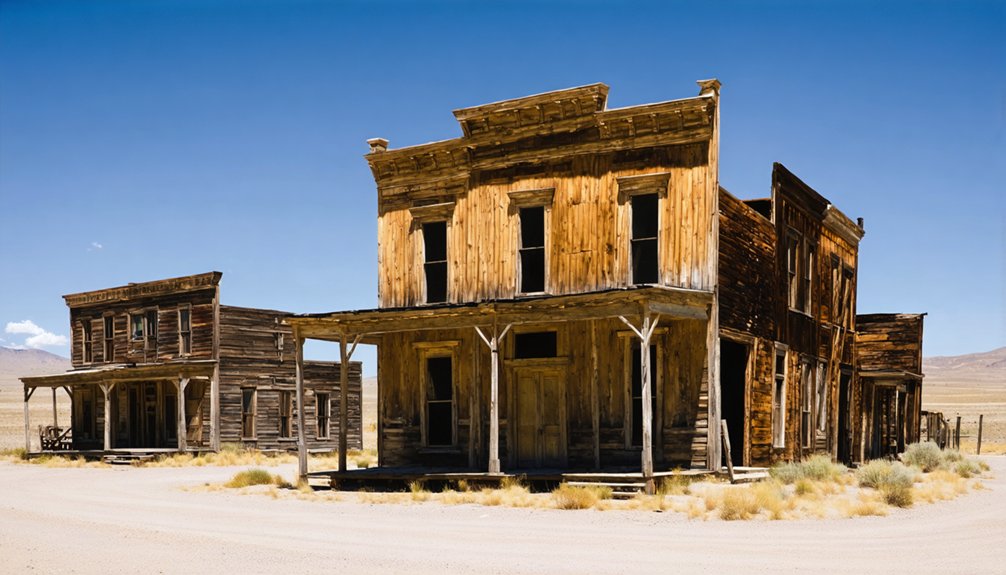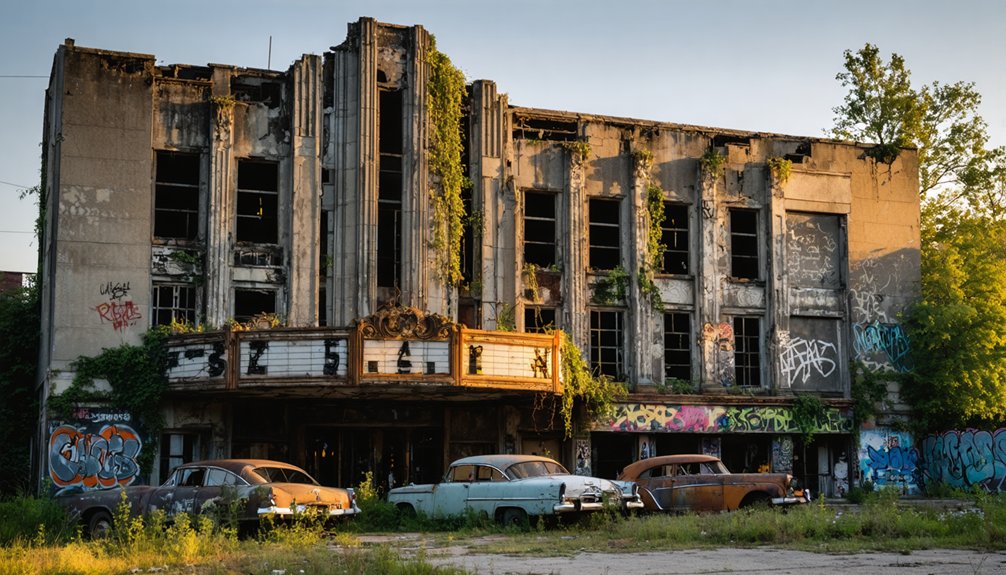You’ll discover America’s most haunting ghost towns in Bodie, California, where gold rush structures stand in “arrested decay,” and Centralia, Pennsylvania, where underground fires still burn. St. Elmo, Colorado preserves mountain mining history, while Frisco, Utah showcases the lawless West with its 23 former saloons. Bannack, Montana, once Montana’s territorial capital, offers 60 historic structures and tales of vigilante justice. These abandoned settlements reveal America’s boom-and-bust cycles beneath their haunting facades.
Key Takeaways
- Bodie, California preserves over 100 original Gold Rush structures in “arrested decay” and warns visitors of a curse for taking artifacts.
- Centralia, Pennsylvania’s underground coal fire continues burning since 1962, creating a toxic, sinkhole-riddled landscape that inspired Silent Hill.
- St. Elmo, Colorado maintains 43 surviving structures from its mining heyday, including a restored schoolhouse and persistent ghostly legends.
- Frisco, Utah’s Wild West ruins include charcoal kilns and a cemetery from its lawless boomtown era that saw daily murders.
- Bannack, Montana preserves 60+ historic structures where visitors report paranormal encounters, including apparitions of the outlaw sheriff.
Bodie, California: Where Time Froze in the Gold Rush Era
While many western boom towns have faded into historical footnotes, Bodie, California stands frozen in time as a premier example of Gold Rush prosperity and subsequent abandonment.
When you visit this authentic ghost town, you’re witnessing the aftermath of W.S. Bodey’s 1859 gold discovery that transformed a modest mining camp into a booming metropolis of nearly 10,000 residents by 1880.
The town that produced $38 million in gold now showcases over 100 original structures in “arrested decay”—exactly as residents left them. The once thriving community included a bustling China Town area with hundreds of residents who contributed significantly to the local economy.
After mining declined and devastating fires struck in 1892 and 1932, Bodie gradually emptied.
Recognized as a National Historic Landmark in 1961 and California’s official gold rush ghost town in 2002, today’s preserved interiors with untouched furniture and personal belongings offer an unparalleled glimpse into authentic frontier life. Many visitors are careful not to remove artifacts due to the legendary curse of Bodie that supposedly brings misfortune to anyone who takes items from the town.
Centralia, Pennsylvania: The Town That Still Burns Below
Unlike most abandoned settlements that slowly succumb to natural forces, Centralia, Pennsylvania represents a unique type of ghost town—one destroyed from below by an unquenchable inferno.
The catastrophe began on May 27, 1962, when a landfill fire ignited an underground coal seam through an incomplete clay barrier. Despite efforts to extinguish it—pumping water into tunnels and filling shafts with non-combustible materials—the underground fire persisted, reaching temperatures exceeding 900 degrees Fahrenheit.
What was once a thriving town of 1,300 residents dwindled to just five by 2020. The mining community’s history extends back to 1842 when the Locust Mountain Coal company purchased the land and planned the village. The government ultimately condemned the entire area and used eminent domain to relocate almost all residents. Toxic carbon monoxide emissions, dangerous sinkholes, and the knowledge that this subterranean blaze might continue for another 250 years drove people away, leaving behind the eerie, smoke-wisped landscape that inspired the horror game Silent Hill.
St. Elmo, Colorado: Whispers From Abandoned Mountain Mines
High in the Colorado Rockies, the ghost town of St. Elmo stands as a well-preserved reflection of America’s mining history. Originally named Forest City, this settlement boomed after prospectors discovered rich silver deposits in 1875.
The Mary Murphy Mine became the district’s crown jewel, producing 220,000 ounces of gold worth $4.4 million by 1925.
You’ll find St. Elmo’s population peaked at 2,000 residents in 1890, but a devastating fire that year marked the beginning of its decline. The town shares its name with St. Elmo Hall, the popular nickname for the fraternity of Delta Phi at various collegiate institutions. As mines depleted and the Alpine Tunnel closed in 1910, the town slowly emptied.
Today, its eerie atmosphere attracts visitors year-round who explore the abandoned structures. Visitors can explore 43 surviving structures, including a restored schoolhouse and town hall. Listed on the National Register of Historic Places, St. Elmo offers a glimpse into the fleeting nature of boomtowns while ghostly legends persist among its stately ruins.
Frisco, Utah: Lawless Wild West Remnants in the Desert
Amid the unforgiving Utah desert, Frisco emerged as a quintessential Wild West boomtown after prospectors discovered rich silver deposits in the San Francisco Mountains in 1875.
Frisco’s lawlessness quickly became legendary. With 23 saloons and daily murders, officials contracted body wagons for corpse removal. The mining boom attracted over 6,000 residents, making it southern Utah’s largest settlement.
The town’s violence only subsided when a ruthless marshal from Nevada killed six outlaws his first night, issuing deadly ultimatums to remaining criminals. Sheriff William Pearson maintained order without a jail, forcing outlaws to either leave town or face violent consequences.
When the Horn Silver Mine collapsed in 1885, Frisco’s fate was sealed. Though no lives were lost in the cave-in, the town’s prosperity vanished. The isolated location in Utah’s West Desert offers visitors a profound sense of solitude when exploring the historic ruins.
Today, you’ll find only haunting ruins—beehive-shaped charcoal kilns and a sprawling cemetery—silent testimonies to the boom-and-bust cycle that defined America’s western frontier.
Bannack, Montana: Gold, Outlaws, and Lingering Spirits
While Frisco’s silver created a deadly desert boomtown in Utah, Montana’s wilderness gave birth to another infamous settlement driven by gold fever. Bannack emerged in 1862 after prospectors discovered gold along Grasshopper Creek, quickly becoming Montana’s first territorial capital.
You’ll find a dark chapter of Wild West history here, where Sheriff Henry Plummer allegedly led the “Innocents” gang while wearing his badge. This corruption sparked Montana’s infamous Vigilante Justice movement, culminating in Plummer’s hanging in January 1864. The gold in the area was remarkably pure at 99 to 99.5 percent, attracting thousands of fortune seekers.
The town offers an annual reenactment called Bannack Days where visitors can experience frontier life firsthand. By the 1960s, dwindling resources had transformed Bannack into a complete ghost town. Today, over 60 historic structures remain preserved as a National Historic Landmark.
Many visitors report paranormal encounters—from slamming doors in vacant buildings to the apparition of a former sheriff patrolling his eternal beat.
Frequently Asked Questions
Can You Legally Spend the Night in Any of These Ghost Towns?
Picture yourself sleeping in a rustic bed and breakfast in St. Elmo, Colorado. You’ll find some ghost towns permit overnight stays, but most have legal restrictions requiring designated lodging or nearby campgrounds.
What Paranormal Investigation Equipment Works Best in Abandoned Mining Towns?
For abandoned mining towns, you’ll need specialized EMF meters to detect electrical anomalies, spirit boxes for potential communication, and environmental monitoring tools designed for extreme conditions and electromagnetic interference.
How Dangerous Are the Structural Conditions of Buildings in These Locations?
Buildings in these locations present extreme dangers due to compromised building stability. You’ll face collapsing floors, deteriorated supports, and falling debris. Always prioritize safety precautions like staying on marked paths.
Do Any Ghost Towns Offer Special Access During Halloween or Solstices?
Thousands of ghost towns release extraordinary Halloween events nationwide. You’ll find paranormal investigator-led experiences during October, requiring advance reservations. Some locations also offer solstice tours, though these are less common than Halloween-specific programming.
Which Ghost Town Has Documented the Most Credible Paranormal Evidence?
Bodie, California is considered the most haunted ghost town with extensive documentation of ghost sightings, featuring consistent reports from diverse sources and systematic paranormal investigation records spanning decades.
References
- https://nightofthejack.com/2025/01/23/top-creepy-ghost-towns-in-america/
- https://en.wikipedia.org/wiki/Wikipedia:WikiProject_Ghost_towns
- https://www.visittheusa.com/experience/5-us-ghost-towns-you-must-see
- https://www.tastingtable.com/694562/scariest-ghost-towns-country/
- https://www.mythfolks.com/haunted-us-ghost-towns
- https://en.wikipedia.org/wiki/Ghost_town
- https://www.realgirlreview.com/dark-tourism-in-america/
- https://www.slideshare.net/slideshow/famous-ghost-towns/26047073
- https://en.wikipedia.org/wiki/Lists_of_ghost_towns_in_the_United_States
- https://noospheregeologic.com/blog/tag/ghost-towns/



